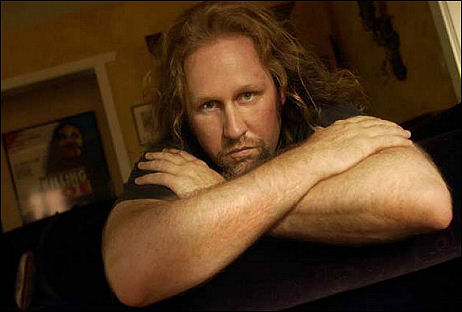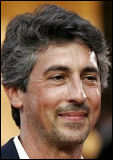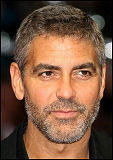Daily
“Occasional Blogging”?
The Scott Foundas slot at the L.A. Weekly/Village Voice has to be filled, of course. Usually the person doing the hiring for such a position will put the word out through the right people and then sift through 15 or 20 resumes and suss things out privately — but not this time. Or maybe there’s an equal opportunity requirement that Village Voice Media needs to make a show (emphasis on that word) of opening the door to any and all applicants.
The following is listed in JournalismJobs.com: “The L.A. Weekly is looking for a film critic/editor. Candidate must have deep knowledge and appreciation of contemporary film and film history, both international and Hollywood. Must write and edit extremely well in formats ranging from short and full reviews to interviews to longer reported features. Essential duties include planning and managing the Weekly‘s film section, including special issues; assigning freelancers; occasional blogging.
“Editor will also coordinate coverage with Village Voice Media for publication of content in 14 newspapers and websites. Ideal candidates will be able to represent the Weekly and VVM at public screenings and other film events, as well as on radio and television. Interested parties should send resume, cover letter and clips to: LAfilmcritic@villagevoicemedia.com.”
“Lovely” and “Powerful”
Just as it can be argued that I tend to approach any Peter Jackson film with a guarded attitude (which really isn’t directed against Jackson as much as any director who incessantly underlines, over-emphasizes and over-cranks the visual razmatazz element as a way of beating his/her chest and saying “look at brilliant me!…look at what I can do!”), it can also be argued or at least suspected that AICN’s Harry Knowles is in the tank for Jackson, and has been there for many, many years.
Knowles has called The Lovely Bones an “incredibly lovely film.” He later says it “will be one of the films of the year,” adding that “some of Peter’s choices in adaptation could very well be hotly debated amongst readers of the book.” He also calls it “an incredibly powerful film, masterfully told and captured as only cinema in the hands of a consummate storyteller can tell it.”
High praise indeed. Harry clearly liked, admired, was touched. And yet I sense a certain caution in the choice of the word “lovely.” I know that on those rare occasions when I see a film that has really knocked me down and turned me around, the word “lovely” never comes to mind. Calling a film ‘lovely” is like saying the girl you went on a blind date last night with has “a terrific personality.”
A little man inside Harry’s chest is telling him, “Go for it, man…you were touched by the film and you should say that. Definitely. Just don’t….well, you know what I mean. Don’t write a full-bodied ecstatic cartwheel rolling-orgasm flutter rave. Save that shit for when you’re feeling it 110% on something really and truly over-the-mountain awesome. We love Peter and Bones is so touching and sad…it is, really…but just, you know, keep things in proportion.”
Damn Dogs
In a review posted sometime earlier today called “Is It Possible To Hate A Film More Than Old Dogs?,” HitFix’s Drew McWeeny begins by saying “if Old Dogs were a person, I would stab it in the face.” That’s pretty good but it would have been better if he’d mentioned the weapon. As in “stab it in the face with a sharp No. 2 pencil” or “stab it in the face with an Exacto knife.”
The worst comedies, I can tell you, always resort to fear-of-nature gags. Movies that cater to or fan this mindset, like the above Old Dogs trailer clearly does, are beyond deplorable.
The idea is that nature will prey on you, kill you, peck you, drown you, piss on you, beat you to death, etc. This, I suspect, is what the average Eloi or middle-aged mall dweller is afraid of, and why a lot of them think global warming isn’t such a bad thing (or at least isn’t something to get too upset over) because who cares if those scary-ass predators have it tough out in the wild? Fuck ’em. We’re doin’ just fine in our sanitized, air-conditioned comfort zone, where nature can’t touch us.
“Millions of years from now,.” McWeeny begins, “after Western Civilization has fallen and the Earth has ruptured and cooled and been reborn and a new life form has taken over the planet, if any of them happen to stumble upon a working DVD player and a copy of Old Dogs,, they will sum up the passing of our culture with two simple words: ‘Good riddance.’
“It is rare that I hate a film with the feverish intensity that I feel towards this one, but it hit pretty much every single button for me, and by halfway through, I felt like I was going to crawl out of my skin.
“What I thought was going to be a mediocre family-themed comedy instead struck me as one of the most singularly vile experiences I’ve had in a theater all year.
“To give you an idea how wretched the film is, if you take the worst Robin Williams film, multiply it by the worst John Travolta film, and then multiply that by Wild Hogs, the last film from director Walt Becker, you would still end up with something better than this.
“Old Dogs is the story of two ostensible adult human beings who, confronted with spending 14 days in the presence of twin seven-year-olds, promptly go insane and begin acting in a manner which would land any person in the real world in jail or the morgue. Deservedly. Nothing in this film resembles any recognizable behavior of any actual person ever.
“At one point, Bernie Mac shows up as a puppeteer who literally wires Robin Williams up with a magical bio-rig that transforms him into…and I quote…a ‘human puppet’ who is controlled via remote by John Travolta so that Williams can have a tea party with his daughter. And although I was sliding in and out of consciousness by this point, numb from the horror, I’m almost positive a Motown song plays over the resulting montage.
“And that is not the worst scene in the film.”
“The 8 to 80 Audience”?
Avatar director James Cameron talking to CNN’s Jason Carroll, in part about whether Avatar is going to get the same kind of repeat business that Titanic attracted. And whether the blog critics who’ve been slamming “the blue characters” have instilled any concern. “If everyone was praising the film too much, that would make me even more nervous,” Cameron replies.
Following The Script
The Reel Geezers — those reliable indicators of smart retirement-age Academy sentiments about current films — are back in action on Indiewire. And as you might expect, they’ve totally rolled over for Precious. Like cocker spaniel puppies with their tongues and tails wagging. The screenplay is “superb,” says Marcia Nasatir, and Lorenzo Semple, Jr. agrees. (God!) This is why Precious is going to be Best Picture nominated — i.e., people and opinions like these.
“Not the usual ‘hood movie, no men in it…no violence,” says Semple. What? Precious is one of the most emotionally violent films I’ve ever seen — that anyone’s ever seen. For me, what happens between Mo’Nique and Gabby in that film is the emotional equivalent of that baseball-bat execution scene in Casino.
“The two social workers and a teacher are almost too good,” Semple continues. “How do you pronounce Mariah Carey‘s name? And then there’s the brilliant, brilliant Mo’Nique…not since Joan Crawford …she is a bad mom.”
“A monster mom,” Nasatir echoes. “And then comes the scene when she explains herself, and I found myself literally gasping at this information.”
Gasping at what exactly? At the notion that director Lee Daniels may be expecting audiences to extend a measure of sympathy to Mo’Nique’s character because of her pathetic “what about me?” explanation? Or that there are actually mothers out there who are capable of treating their daughters this way?
There are two questions that the Geezers never raise or answer. Would they go to see Precious a second time? And if so, why?
Nasatir then says, “They also show a clip from Two Women, the marvellous Anna Magnani movie.” She’s confusing Two Women, a 1960 Vittorio DeSica film, with Rossellini’s Open City (’45). Two Women costarred Sophia Loren, Jean-Paul Belmondo, Eleonora Brown and Raf Vallone.
Hawaii, Money, Death & Family
If anyone has a copy of The Descendants, the Nat Faxon-Jim Rash screenplay that Alexander Payne will begin directing early next year with George Clooney in the lead role, please send along. This Hawaiian-based adaptation of the ’07 Kaui Hart Hemmings novel will be released in 2011 by Fox Searchlight.
The plot summaries I’ve read on movie sites made no sense so I’ve pasted two — one from Publisher’s Weekly, another from The New Yorker — from the book’s Amazon page.
(From Publishers Weekly): “Hemmings’ bittersweet debut novel stars besieged and wryly introspective attorney Matt King (Clooney), the land-rich descendant of Hawaiian royalty and American missionaries and entrepreneurs. He wrestles with the decision of whether to keep his swath of valuable inherited land or sell it to a real estate developer. But even more critical, Matt also has to decide whether to pull the plug on his wife, Joanie, who has been in an irreversible coma for 23 days following a boat-racing accident.
“Then Matt finds out that Joanie was having an affair with real estate broker Brian Speer, impelling him to travel with his two daughters — precocious 10-year-old Scottie and fresh-from-rehab 17-year-old Alex — from Oahu to Kauai to confront Brian. Matt finds out the truth about Joanie and Brian, which influences his decision about what to do with his family’s on-the-block land and complicates his plans for Joanie. Matt’s journey with his girls forms the emotional core of this sharply observed, frequently hilarious and intermittently heartbreaking look at a well-meaning but confused father trying to hold together his unconventional family.”
(From The New Yorker): “The narrator of this audaciously comic debut novel, the scion of the last Hawaiian landowning clan, has floated through his privileged life: marriage to a model given to ‘speedboats, motorcycles, alcoholism’; children getting into trouble (cocaine, bullying) at elite schools; membership at a century-old beach club that rejects those with ‘unfavorable pedigrees.’
“But when a catamaran accident leaves his wife in a coma he must wake from his own ‘prolonged unconsciousness,’ reacquaint himself with his neglected daughters, and track down his wife’s lover. Meanwhile, his cousins are urging him to sell the family’s vast landholdings for development — to relinquish, in his eyes, the final vestige of their native Hawaiian ancestry. Hemmings channels the voice of her befuddled middle-aged hero with virtuosity, as he teeters between acerbic and sentimental, scoffing at himself even as he grasps for redemption.”
Straight out of serious Clooney/Oscar-bait handbook. Matt King is the brother of Ryan whatsisname, the flyaway guy Clooney plays in Up In The Air.
Free AT&T Service for Life?
I first saw Luke Wilson‘s “better 3G experience” AT&T ad yesterday. My first thought was “why is he doing this?” Then I figured okay, the last thing he did that really connected was his nice-guy-brother role in The Family Stone, and Luke’s last semi-popular Eloi movie was My Super Ex-Girlfriend and…well, also that Henry Poole Is Here didn’t fly and TV ads pay pretty well. Nothing wrong with a little financial fortification.
Then I thought “gee, maybe Luke should work out a bit more, drop a few pounds.” Then I wondered where the trailer is to Neil Labute‘s upcoming Death at a Funeral (Screen Gems, 4.16), a mostly black remake of the ’09 British comedy that Wilson costars in. Then I remembered that I almost bought the Blu-ray Bottle Rocket a couple of days ago but that I held back because what I really want is a Blu-ray Rushmore.
“Doing Nothing Deliberately”
If — I say “if” — this trailer is a fair and accurate representation of Noah Baumbach‘s Greenberg (Focus Features, 3.12.10) then it’s going to be one of 2010’s smartest and most engaging films hands down, and why the hell didn’t they open it this year? (Too costly?) I wasn’t exactly pining for a dry, witty, low-key portrait of a 40ish L.A. loser, but this thing has me hooked. Focus should bring Greenberg to Sundance, where it’ll most assuredly kick ass.
It looks like Ben Stiller might have lucked into his best role ever, and possibly given his career-best performance…maybe. It looks like a breakthrough also for mumblecore veteran and Joe Swanberg colleague Greta Gerwig (Baghead, Hannah Takes The Stairs, Nights and Weekends). And Mark Duplass and Jennifer Jason Leigh are in it…great!
And Rhys Ifans…okay, I’m now even ready to forgive Ifans for playing that dreadful hippie creep in Enduring Love (’04), one of the most thoroughly repellent films of the 21st Century. (I realize, Roger Michel, that the opening sequence with the big helium balloon and the guy falling from it was amazing.)
The IMDB synopsis: “A New Yorker moves to Los Angeles in order to figure out his life while he housesits for his brother, and he soon sparks with his brother’s assistant.”
You can tell that Baumbach’s writing (he and Jason-Leigh share story credit) is spot-on, and that he (or they) may have tapped into something really primal and affecting this time around. Stiller’s character almost reminds me at times of my recently deceased brother, although my brother wasn’t as funny. (“I’d go further — I’d say ‘life is wasted on…people.'”)
If this isn’t a wank (an assemblage of the film’s best parts, and therefore a concealment of the fact that the rest of the film isn’t as good), Greenberg looks like the shit.
(The song is LCD Soundsystems’ “All My Friends.” Terrible news about drummer Jerry Fuchs, who died on 11.9 after falling five stories down an elevator shaft in Brooklyn.)
Each Dawn I Die
“C’mon and do the jailhouse twitter wit’ me, lehhzz rock…everybahdy lehhzz rock …everybahdy on ole ‘ cell block was checking out Avary’s latest!” – “Jailhouse Twitter” lyrics by Jerry Leiber and Mike Stoller.

L.A. Times technology columnist Mark Milian has finally posted about Roger Avary‘s tweets from the Ventura County jail, which everyone who knows or is plugged into anything has been talking about for the last week or two.
“As is often the case with Twitter, screenwriter Roger Avary recently tweeted about what he had for lunch. It was soy, which, an acquaintance told him, contains a dangerous substance intended to shrink their genitals and reduce their sex drives.
“Just another day in Ventura County Jail.
“Avary, who won an Oscar for writing the Pulp Fiction screenplay, appears to be sending updates to Twitter from the big house. He received a jail sentence in September after pleading guilty to vehicular manslaughter following a fatal crash last year.
“We can’t confirm that the Twitter account, @avary, actually belongs to Avary. But a second account, @rogeravary, points to the companion profile and contains photos of sci-fi author Neil Gaiman and the Dresden Dolls’ Amanda Palmer.
“Gaiman’s Twitter profile and @FoxSearchlight are among @avary’s 9,538 followers. Gaiman recently sent a tweet that read, ‘My friend @AVARY is tweeting from the inside. It’s riveting, horrible strange. Jail in 140 character lumps.’
“The Avary tweets are truly intense. On Saturday, he reported the facility being locked down due to an inmate sneaking in heroin. On Sunday, he said a ‘sickness’ has been spreading throughout the compound, which ‘#34’ (what he has been calling himself since being locked up) is ‘helpless to avoid.'” (Again from Leiber and Stoller: “Number 34 said to number 3, ‘You da cutest jailbird I ever did see.'”)
“All of Avary’s tweets have come between 8 a.m. and 5 p.m. Some on Twitter believe he has regular computer access. The majority of his messages were sent via a Web browser, but a couple came through Twitterrific, an application for the Mac and iPhone — it’s unclear which device he’s using.
“The U.S. Senate has been looking into passing a nationwide ban on cellphones in prison using service jammers.”
Giving Thing
The idea behind Charity Buzz.com, as you might imagine, is to cough up a little something for your favorite cause. It’s good for the soul if you can afford to give (and I realize this is a rough time for a lot of people). Plus “this is the time of year when want is felt most deeply,” as Charles Dickens once wrote. In any event I’m passing along an opportunity to have dinner with the great Eva Marie Saint. If you win out the money will go to Children’s Neurobiological Solutions Foundation.

Eva Marie Saint, Jeffrey Hayden
The problem is that it’s a package deal — dinner not just with Ms. Saint but also her husband, director-producer Jeffrey Hayden. I need to put this delicately but…well, three’s a crowd. If I were in Jeff’s position I’m sure I’d understand completely. If I were bidding I’d want to settle down with Ms. Saint and charm her into dishing the dirt about her 1950s and ’60s costars — the dirt that she refuses to get within 50 feet of in interviews (like this one with Kim Morgan).





